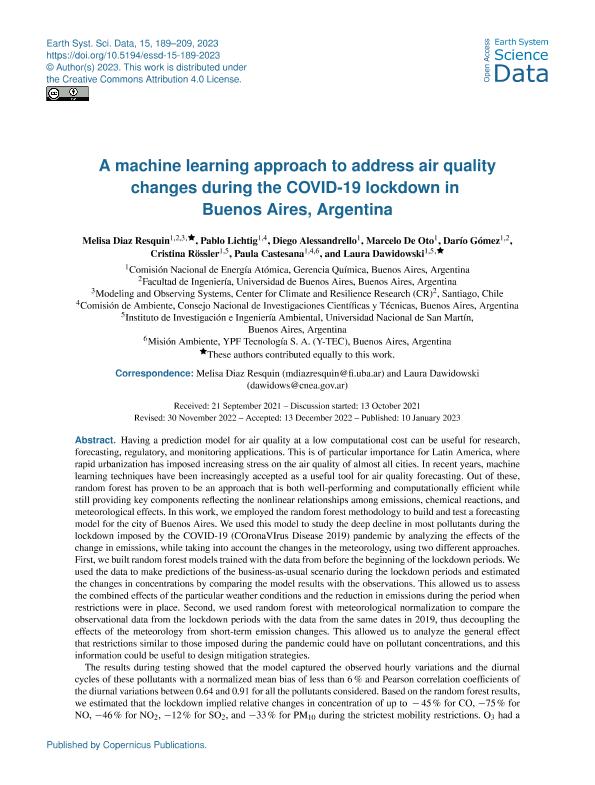Mostrar el registro sencillo del ítem
dc.contributor.author
Diaz Resquin, Melisa

dc.contributor.author
Lichtig, Pablo

dc.contributor.author
Alessandrello, Diego

dc.contributor.author
De Oto, Marcelo
dc.contributor.author
Gómez, Darío
dc.contributor.author
Rossler, Cristina Elena

dc.contributor.author
Castesana, Paula Soledad

dc.contributor.author
Dawidowski, Laura Elena

dc.date.available
2023-11-28T15:59:25Z
dc.date.issued
2023-01
dc.identifier.citation
Diaz Resquin, Melisa; Lichtig, Pablo; Alessandrello, Diego; De Oto, Marcelo; Gómez, Darío; et al.; A machine learning approach to address air quality changes during the COVID-19 lockdown in Buenos Aires, Argentina; Copernicus Publications; Earth System Science Data; 15; 1; 1-2023; 189-209
dc.identifier.issn
1866-3508
dc.identifier.uri
http://hdl.handle.net/11336/218709
dc.description.abstract
Having a prediction model for air quality at a low computational cost can be useful for research, forecasting, regulatory, and monitoring applications. This is of particular importance for Latin America, where rapid urbanization has imposed increasing stress on the air quality of almost all cities. In recent years, machine learning techniques have been increasingly accepted as a useful tool for air quality forecasting. Out of these, random forest has proven to be an approach that is both well-performing and computationally efficient while still providing key components reflecting the nonlinear relationships among emissions, chemical reactions, and meteorological effects. In this work, we employed the random forest methodology to build and test a forecasting model for the city of Buenos Aires. We used this model to study the deep decline in most pollutants during the lockdown imposed by the COVID-19 (COronaVIrus Disease 2019) pandemic by analyzing the effects of the change in emissions, while taking into account the changes in the meteorology, using two different approaches. First, we built random forest models trained with the data from before the beginning of the lockdown periods. We used the data to make predictions of the business-as-usual scenario during the lockdown periods and estimated the changes in concentrations by comparing the model results with the observations. This allowed us to assess the combined effects of the particular weather conditions and the reduction in emissions during the period when restrictions were in place. Second, we used random forest with meteorological normalization to compare the observational data from the lockdown periods with the data from the same dates in 2019, thus decoupling the effects of the meteorology from short-term emission changes. This allowed us to analyze the general effect that restrictions similar to those imposed during the pandemic could have on pollutant concentrations, and this information could be useful to design mitigation strategies. The results during testing showed that the model captured the observed hourly variations and the diurnal cycles of these pollutants with a normalized mean bias of less than 6 % and Pearson correlation coefficients of the diurnal variations between 0.64 and 0.91 for all the pollutants considered. Based on the random forest results, we estimated that the lockdown implied relative changes in concentration of up to −45 % for CO, −75 % for NO, −46 % for NO2, −12 % for SO2, and −33 % for PM10 during the strictest mobility restrictions. O3 had a positive relative change in concentration (up to an 80 %) that is consistent with the response in a volatile-organic-compound-limited chemical regime to the decline in NOx emissions. The relative changes estimated using the meteorological normalization technique show mostly smaller changes than those obtained by the random forest predictive model. The relative changes were up to −26 % for CO, up to −47 % for NO, −36 % for NO2, −20 % for PM10, and up to 27 % for O3. SO2 is the only species that had a larger relative change when the meteorology was normalized (up to 20 %). This points out the need for accounting not only for differences in emissions but also in meteorological variables in order to evaluate the lockdown effects on air quality. The findings of this study may be valuable for formulating emission control strategies that do not disregard their implication on secondary pollutants. We believe that the model itself can also be a valuable contribution to a forecasting system in the city and that the general methodology could also be easily applied to other Latin American cities as well. We also provide the first O3 and SO2 observational dataset in more that a decade for a residential area in Buenos Aires, and it is openly available at https://doi.org/10.17632/h9y4hb8sf8.1 (Diaz Resquin et al., 2021).
dc.format
application/pdf
dc.language.iso
eng
dc.publisher
Copernicus Publications

dc.rights
info:eu-repo/semantics/openAccess
dc.rights.uri
https://creativecommons.org/licenses/by/2.5/ar/
dc.subject
Machine leraning
dc.subject
Random Forest
dc.subject
Air Quality
dc.subject
COVID-19
dc.subject.classification
Ciencias Medioambientales

dc.subject.classification
Ciencias de la Tierra y relacionadas con el Medio Ambiente

dc.subject.classification
CIENCIAS NATURALES Y EXACTAS

dc.title
A machine learning approach to address air quality changes during the COVID-19 lockdown in Buenos Aires, Argentina
dc.type
info:eu-repo/semantics/article
dc.type
info:ar-repo/semantics/artículo
dc.type
info:eu-repo/semantics/publishedVersion
dc.date.updated
2023-11-28T14:52:10Z
dc.identifier.eissn
1866-3516
dc.journal.volume
15
dc.journal.number
1
dc.journal.pagination
189-209
dc.journal.pais
Alemania

dc.journal.ciudad
Göttingen
dc.description.fil
Fil: Diaz Resquin, Melisa. Centro de Ciencia del Clima y la Resiliencia; Chile. Comisión Nacional de Energía Atómica; Argentina. Universidad de Buenos Aires. Facultad de Ingeniería; Argentina
dc.description.fil
Fil: Lichtig, Pablo. Consejo Nacional de Investigaciones Científicas y Técnicas; Argentina. Comisión Nacional de Energía Atómica; Argentina
dc.description.fil
Fil: Alessandrello, Diego. Comisión Nacional de Energía Atómica; Argentina
dc.description.fil
Fil: De Oto, Marcelo. Comisión Nacional de Energía Atómica; Argentina
dc.description.fil
Fil: Gómez, Darío. Comisión Nacional de Energía Atómica; Argentina. Universidad de Buenos Aires. Facultad de Ingeniería; Argentina
dc.description.fil
Fil: Rossler, Cristina Elena. Comisión Nacional de Energía Atómica; Argentina. Universidad Nacional de San Martín. Instituto de Investigación e Ingeniería Ambiental. - Consejo Nacional de Investigaciones Científicas y Técnicas. Oficina de Coordinación Administrativa Parque Centenario. Instituto de Investigación e Ingeniería Ambiental; Argentina
dc.description.fil
Fil: Castesana, Paula Soledad. Consejo Nacional de Investigaciones Científicas y Técnicas; Argentina. Comisión Nacional de Energía Atómica; Argentina. YPF - Tecnología; Argentina
dc.description.fil
Fil: Dawidowski, Laura Elena. Comisión Nacional de Energía Atómica; Argentina. Universidad Nacional de San Martín. Instituto de Investigación e Ingeniería Ambiental. - Consejo Nacional de Investigaciones Científicas y Técnicas. Oficina de Coordinación Administrativa Parque Centenario. Instituto de Investigación e Ingeniería Ambiental; Argentina
dc.journal.title
Earth System Science Data
dc.relation.alternativeid
info:eu-repo/semantics/altIdentifier/url/https://essd.copernicus.org/articles/15/189/2023/
dc.relation.alternativeid
info:eu-repo/semantics/altIdentifier/doi/http://dx.doi.org/10.5194/essd-15-189-2023
Archivos asociados
